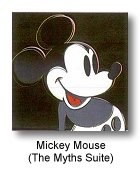| Born Andrew Warhola on August 6, 1928 (some sources say 1927), in Forest City, Pennsylvania, the son of a construction worker and miner from Czechoslovakia. He attended the Carnegie Institute of Technology in Pittsburgh from 1945-1949, receiving a bachelor of fine arts degree in pictorial design. Warhol liked to shroud himself in mystery. "I never give my background, and anyway, I make it all up differently every time I'm asked," he said. His exact birth date and place only add to this mystery. Warhol provided no information on the matter, so any definitive statement is subject to question. In 1949 Warhol arrived in New York City, where he made a meager living in advertising display work. He took some of his drawings to Glamour magazine and received a commission to make drawings of shoes. These were published and admired; he then worked for a shoe chain. In 1957 a shoe advertisement brought him the Art Directors' Club Medal. His work appeared in Vogue and Harper's Bazaar magazines, and in 1959 he exhibited his gold shoe drawings in a New York City gallery. In 1960 Warhol began painting pictures with no commercial market in mind. He did a series on comic strips such as Dick Tracy, Popeye, Superman and the Little King. His paintings of Coca Cola bottles and Campbell soup cans, arranged in seemingly endless rows, were ridiculed when they were first shown. He created paintings of money and silk-screen portraits of Marilyn Monroe. His second New York show in 1962 was a critical success and perfectly timed, as pop art was just becoming an acceptable art form. His fascination with silk screen as an instrument for mass production led him to open a studio, dubbed The Factory, where he later made his films. The Factory became a center for pop and would-be pop stars. It attracted a wide variety of glamorous people and an assortment of characters in the art and performing worlds. Although many of Warhol's films, such as Sleep (1963), Eat (1963), and Empire (1965), were lengthy depictions of the most mundane activity or object, some of his works anticipated future film themes or ridiculed certain subjects. Lonesome Cowboys (1968) treated homosexuality when it was taboo as a subject for commercial films and, at the same time, challenged the cowboy myth of courageous, macho riders of the range. With such works as Flesh (1968) and Trash (1970), Warhol focused on sexual themes. These were the forerunners of the pornographic film market of the 1970s and 1980s. By the mid-1970s his Andy Warhol's Dracula (1974) and Andy Warhol's Frankenstein (1974) enjoyed commercial success as satiric yet serious works. From 1963 to 1974, he had been involved in the production of more than sixty films of varying quality and subject matter. Warhol and other pop artists drew their inspiration and imagery from popular culture, but they heightened the color and changed the scale to make the images larger than life. In doing so they redefined pictorial realism and extended its concept. Warhol's imagery can be classified in four broad categories: commercial products such as Brillo boxes and Heinz ketchup bottles, personality portraits of celebrities, modes of exchange such as trading stamps and bills, and disaster pictures of automobile accidents, electric chairs, gangster funerals and race riots. In 1968 Warhol's celebrity status nearly cost him his life. A disturbed visitor to The Factory shot him, inflicting serious internal wounds. Warhol's slow recovery included a two-month hospital stay and a turn to a new direction, his post-Pop period. From 1970 onward, he increasingly turned to producing portraits of cult figures, prominent persons, and personal friends. These portraits, of figures such as Mao Tse-tung, Philip Johnson, Mick Jagger, Jimmy Carter, and Merce Cunningham display a softer, more delicate imagery than Warhol's earlier Pop Art paintings. His art of the 1970s moved closer to an abstract expressionist style and away from the figurative or realistic style of his work in the 1960s. In 1981 he undertook a series of myth paintings in which the subject matter treated mythical figures from popular culture sources, such as advertisements, comic strips and films. These works included Dagwood, Mickey Mouse, and Superman. Later in 1983 he created a series of endangered species paintings which depicted various threatened wildlife. As in all of his work, Warhol selected subjects with great popular imagery and treated the symbol and image as much as he does the real object itself. As a social commentator (a role he denied), Warhol had the uncanny ability to mirror the trends and fads of his time. Recognizing the elements of an urban mass society heavily influenced by symbols, images, and the mass media, he made those symbols and images the subjects of his art. For Warhol and other Pop artists, these images have taken on a reality of their own. They were not only shaped by but also reshaped popular culture. Warhol left social and cultural historians visual documents of the significant elements from America's consumerist society of the postwar era--an important legacy. Warhol died of heart failure hours after undergoing gall bladder surgery on February 22, 1987, in New York City. © Biography Resource Center, 2001 Gale Group |




